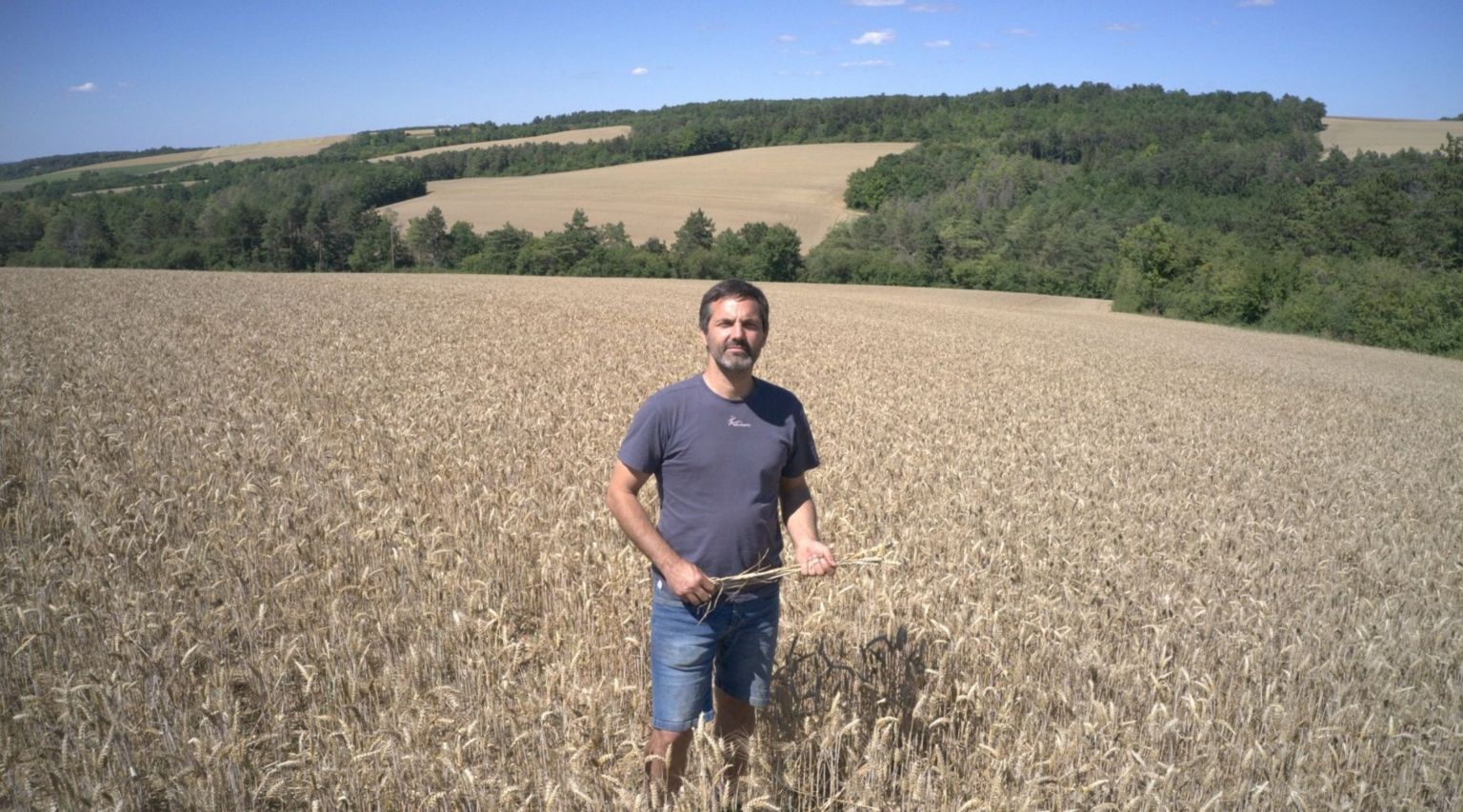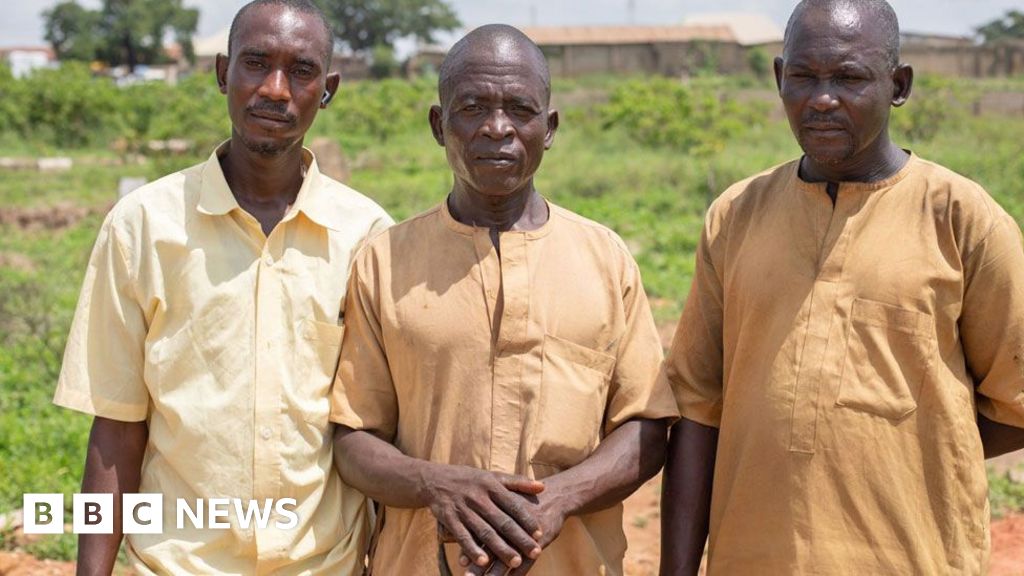ARTICLE AD BOX
By Stephanie Hegarty
Population correspondent

As harvest time looms for the world's main wheat producers, countries that import wheat are hoping for a bumper global crop so that record high prices might fall. But analysis on the health of crops around the world, shared with the BBC, suggests that's unlikely, and that Russia could be the only big winner.
From his farm three hours south-east of Paris, Sébastien Neveux is worried. Here in France's main wheat-producing region, the weather has been strange recently.
It was extremely dry in March, April and May, a crucial time for wheat crops in France which need moisture to pull minerals up from the ground. Then, in June, there was heavy rain and hail. It was too much, too late.
"I'll have lost 40% of this field because of drought and intense heat," says Mr Neveux. He estimates he'll lose 25% of his wheat crop overall.
Working with two companies that analyse data on crop health, the BBC has found that some of the world's main wheat producers could see weaker harvests than anticipated this year because of bad weather.
In the EU that could mean 4.7 million tonnes less wheat than last year, which is bad news for countries hoping to find alternatives to Ukrainian wheat.
The analysis looked at information from satellite images, which can determine how healthy a plant is by how much infrared light the plant reflects back at the satellites' cameras. That information is then cross-referenced with data about weather and soil moisture to indicate the potential harvest.
Standing in his wheat field, Mr Neveux pulls two stalks from the ground. One is long and golden, the other short and blackened. Rolling each ear between his palms, he blows away the husks to reveal the grains inside. The healthy plant has many plump grains, the other one has just a couple of shrivelled ones. It's disappointing.
"The grain won't have the right quality for milling flour. It'll have to go to cow or chicken feed. So I'll sell it for less," he says.
More than a third of the planet relies on wheat as a staple food. It provides more calories in the world's diet than any other single crop. And as the global population is growing, every year we have to produce more.
At the beginning of 2021 wheat prices were at a record high, thanks to a spike in demand after the coronavirus pandemic and bad harvests in some major exporting countries. Then Russia invaded Ukraine - the world's fifth biggest wheat exporter - and prices soared even higher, sparking concerns of a global hunger crisis.
According to analysis shared with the BBC by Kayrros and EarthDaily Analytics, three of the world's five major wheat exporters (the US, France and Ukraine) could see lower than expected yields this year.
The US is the world's third-biggest wheat exporter but severe drought in spring in two main wheat-producing states, Kansas and Oklahoma, could mean yields are 7-8% lower this year than the five-year average.
India also produces vast volumes of wheat, most of which is consumed within the country. This year India increased the amount of wheat planted, leading many to hope it could become a significant exporter and ease the strain on global supplies. But extreme heatwaves hit India just as the crop was at a crucial stage for developing grain.
In response, the Indian government put an export ban on wheat in early May. EarthDaily's analysis suggests that India's production this year has been 10 million tonnes lower than expected.
Not everywhere has seen disastrous weather though. Canada experienced very severe drought last year which led to historically low yields for wheat. This year the crop is looking much healthier, and EarthDaily estimates that the harvest will be above the five-year average.
In Russia, the world's largest wheat exporter, the crop is looking particularly promising. Thanks to very favourable weather its yields could be 6% higher than average this year, leading to fears that Russia could use grain for political leverage.
Margarita Simonyan, editor-in-chief of the Russian state-controlled news network Russia Today, joked at the St Petersburg Economic Forum in June about how Moscow could exploit the crop, commenting that she had heard people saying, "All hopes are pinned on the famine."
"It means that a famine is about to start and now they will come to their senses and lift sanctions, and generally make friends with us," she continued, "because they will realise that it's impossible not to be friends with us."
In response, Russian President Vladimir Putin said the country had no plans to restrict access to its grain.
But Russia's crop may not be enough to offset deficits elsewhere in the world, says Elena Neroba, a Ukrainian grains analyst with the trading firm, Maxigrain. And Russia could find it difficult to sell. Food is not subject to sanctions, but the restrictions make doing business with Russia complicated.
"Really big companies will avoid trading with Russia because it's a huge risk. If you are a state reserve or a multinational company, it's not just the risk of a volatile price, it's a risk to your reputation," Ms Neroba says.
It's also unclear how much of Ukraine's wheat will make it out of the country, as Russia has been attacking grain stores, dropping incendiary bombs on fields of dry crops, and blockading the main export route via ports in the Black Sea.
As wheat harvests get under way, prices are dropping slightly but they are still 48.5% higher than this time last year, according to the UN's Food and Agriculture Organization (FAO).
Price is determined by supply and demand and it is heavily influenced by expectation. Earlier this year expectations were high for the wheat crop in most regions, but war and bad weather dashed those hopes.
Sébastien Neveux holding grains of wheat from one stem that has grown successfully, and one that hasn't
The FAO is more optimistic about the crop in the US than the satellite-based analysis from Kayrros and EarthDaily. But it predicts that global wheat production will decline by 0.8% or three million tonnes. That doesn't mean a major shortage of wheat but it does ensure prices will remain high, hitting low-income countries that rely on wheat imports the hardest.
The FAO's chief economist, Maximo Terero, is especially worried about next year, if the war continues and farmers can't access fertiliser, much of which comes from Russia.
"If we continue to have increasing prices of fertilisers, there is potential risk that yields will reduce," he says. "And that's when we could be talking about a huge food crisis."
The pandemic and the invasion of Ukraine have exposed just how vulnerable our global food system is to shocks. Climate change, which makes extreme and unpredictable weather more common, means more shocks are sure to come.
"Four or five countries control the major share of the wheat exports in the world," says Mr Terero. "If something happens to any of these countries because of extreme weather conditions, it will immediately have an impact on world exports."
Farmers like Sébastien Neveux have no choice but to try to adapt. He's in his early 40s and inherited the farm from his father, but the way he must farm is different now.
"We need to find plants that are more resistant. And they have to become resistant more quickly to survive climate change. The natural cycle of selection is not going to adapt quickly enough."
Marching through his wheat field he stops to pull another small, stunted stalk from the ground. Though this damaged plant won't make him any profit, he turns it over in his hands admiringly. It's sad, he says - but it also gives him hope.
"It does everything it can to fight, to produce, to make grain," he says. "It has this extraordinary instinct to survive."

 2 years ago
57
2 years ago
57








 English (US) ·
English (US) ·